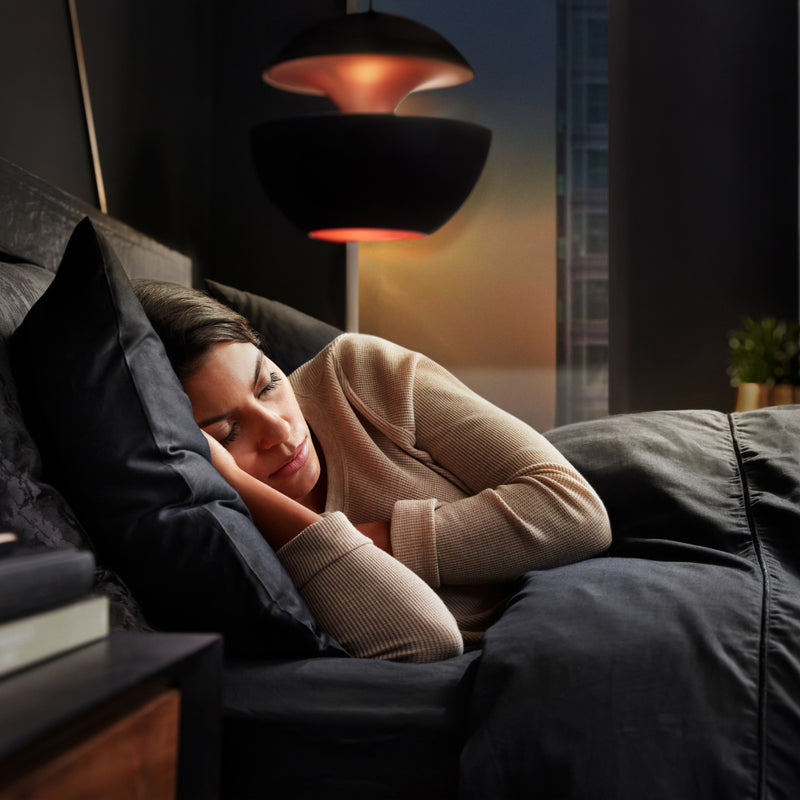Dr. Rebecca Robbins is a sleep researcher whose work examines how sleep impacts our daily lives and can help us meet our full potential. She is partnering with Beautyrest to put a renewed focus on sleep"exploring the connection between sleep and other aspects of our lives. She will be providing ongoing insights from scientific literature as well as strategies for optimal rest and recovery.
Our senses, such as sight, sound, and smell, all impact our ability to fall asleep and stay asleep. Sound is one factor that has a particularly pronounced impact upon sleep. Unfortunately, disruptive sounds (e.g., fire engines, motorcycles, dogs barking) are one silent thief in the night, robbing you of the restorative rest your body so desperately needs. On the other hand, evidence suggests that sound can also be a powerful contributing force to release stress, tension, and prepare your body for the sound slumber that will allow you to wake up to a productive tomorrow.
Sound and Sleep: Examining the Evidence
Calming sounds, like rainforest sounds or peaceful music, can soothe and transport us. Soft sounds ease our mind away from unhealthy thought patterns or stressors and induce relaxation"all essential components of restorative rest.
For these reasons, music and sound therapy are part of a suite of recommendations for healthy sleep, and there's research to support it.
First, research among older patients (average age was around 70) with sleep difficulty found listening to music before bed was associated with several signs of improved sleep health, including longer sleep duration and reduced sleep latency (Lai & Good, 2006). Also, research with post-operative patients found listening to music was associated with improved sleep and even lower pain than patients who did not listen to music (Zimmerman et al., 1996). Finally, when white noise was played, or a soft sound with equal intensities, for newborns, 80% fell asleep within five minutes compared to only 25% falling asleep in five minutes without white noise (Spenser et al., 1990).
Consequently, sound can be used to improve sleep, particularly among those experiencing difficulty falling asleep.
Which Tunes to Choose for Optimal Rest
It may not surprise you that store shelves are full with sound producing gadgets and gizmos for inducing relaxation and rest. Which tones should you choose to help you relax and slip into sleep?
Research suggests specific types of sound may be beneficial. For instance, research has found the sound of naturally occurring phenomena, such as rainfall, termed "pink noise," played throughout the night, can improve sleep parameters and enhance memory consolidation (Papalambros et al, 2017). Other research has drawn attention to a type of music termed binaural beat technology (BBT) and its implications for sleep. Research among veteran soldiers with post-deployment stress suggests listening to BBT music may be associated with reduced stress, lower heart rate, and improved sleep (Gant et al., 2017).
If you are experiencing sleep difficulty, you may consider trying a standalone gadget or mobile app that produces sound to help ease you into the rest to wake up to a productive tomorrow.
The Downside to Sound
While soothing sounds can improve sleep, there is a downside to sound, particularly when it is unwanted at night. Noises in our environment can be out of control and is a particularly pressing issue for health in urban settings that are densely populated with individuals who may have differing patterns of their wakefulness and sleep.
Also, in our 24-7 society, trash removal, road maintenance, and construction often are scheduled at night so as to reduce adverse impacts on traffic congestion during the daylight which can introduce noise that might affect sleep quantity and quality.
In research with a large sample of adults living in Finland, exposure to nighttime outside noise was associated with about 1.3 times more insomnia (e.g., difficulty maintaining sleep, or waking up too early) than to individuals who were not exposure to nighttime noises (Halonen et al., 2012).
Keeping Unwanted Sound At Bay
Unfortunately, nighttime noise can sometimes be out of our control and is a problem for many of us. In New York City alone, there are over 420,000 complaints about nighttime noise each year. According to the American Speech Language Center, noise in decibels of about 40 is the noise level of a quiet room and is thus optimal for sleep. Noise of 60 decibels, however, or the sound of a quiet conversation, is enough to disrupt sleep.
If you find noise routinely interrupts your sleep, you may consider protecting yourself with earplugs to block out noise that might interrupt your sleep. Earplugs come in different shapes, textures, and sizes and can cut down noise by up to 30 decibels.
Another strategy for keeping unwanted noise at bay is to use white or pink noise that creates a background level of noise to dampen intermittent sounds that might cause you to awaken from sleep.
Sound is intimately related to the quality and quantity of our rest. Sound can be used to your advantage, but it can also disrupt the quality of your sleep. If you experience difficulty sleeping, you may consider including light, relaxing music, pink or white noise into your bedtime routine to wake up to a productive tomorrow.
References
Gant et al. (2017)
Hanolen et al. (2012)
Papalambros et al. (2017)
Lai & Good (2006)
Zimmerman et al. (1996)
Spencer et al. (1990)
American Speech Language Center


